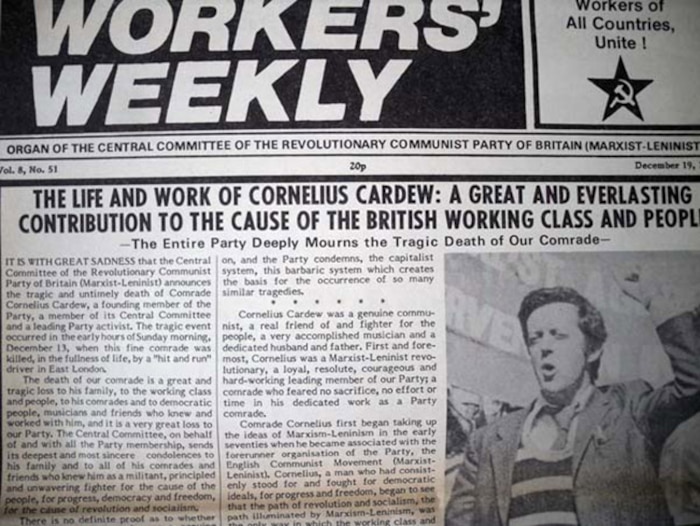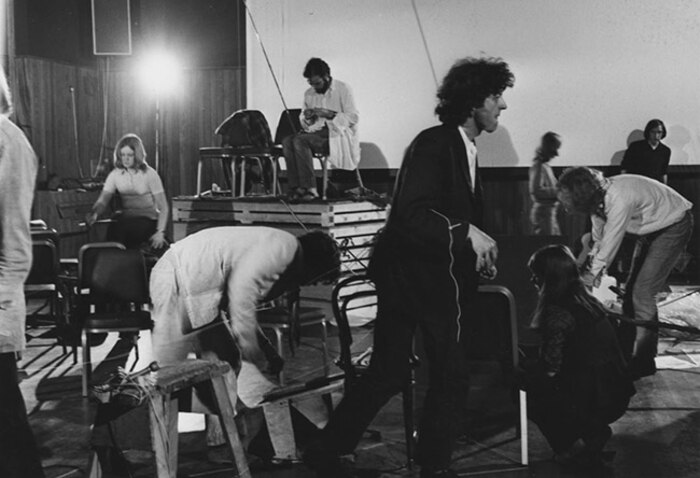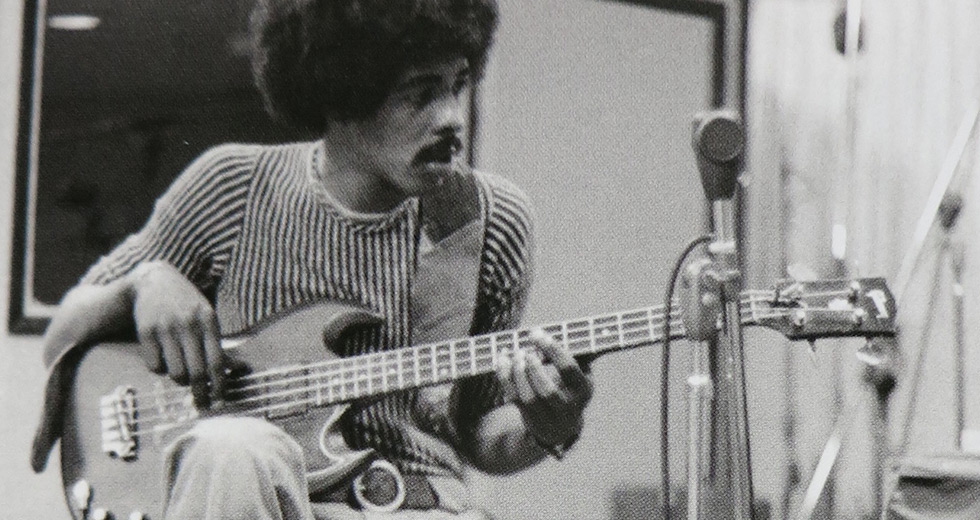Starting From Scratch: Cornelius Cardew and the Orchestra as Insurgency
A little after 1 AM on the night of December 12th 1981, a noise from the street prompted a mini-cab driver to dash out of his office in East London. Sprawled across the road, a body lay with its head smashed in and one leg almost dismembered. Further down the hill, the cabbie saw a Renault brake sharply. Someone got out of the car and looked up the road – long enough to see the corpse and the man standing over it – before switching off the headlamps and careening off the wrong way down a one-way street.
At the inquest, none of the assembled experts were able to explain these peculiarly violent wounds, nor how a supposed hit-and-run had managed to impact both legs and head alike. Still, a verdict of accidental death was registered. The police investigation had been perfunctory to the point of wilful negligence. Signs erected at the crime scene got the colour of the car wrong. A newspaper ad appealing for witnesses even misidentified the victim.
The deceased was a member of the Central Committee of the Revolutionary Communist Party of Britain (Marxist-Leninist). Over the preceding years he had clashed numerous times with far-right political groups in East London. Just six weeks before his death he had been arrested at the House of Commons for scattering leaflets and shouting, “This house stinks of racism!” during a speech by the Ulster Unionist MP (and former Conservative Health Minister) Enoch Powell.
In the coded communications of his Party, the dead man had been known as Ernest. But he was born Cornelius Cardew, in Winchcombe, Gloucestershire, in 1936, and he was one of the most fascinating composers of the 20th century. Michael Nyman had first spoken of musical “minimalism” in a review of one of his works; Brian Eno was a fan. So was Robert Wyatt, who called Cardew “a real fountain of breathtakingly adventurous music.” But at the time of his death, Cardew’s works were spurned and few obituaries treated him kindly.

Two decades earlier, Cardew was Britain’s most important exponent of modern music. Upon leaving the Royal College of Music in 1957, he had left for Cologne to serve an apprenticeship at the electronic music studio of the Westdeutscher Rundfunk. There he became the friend and protégé of Karlheinz Stockhausen and assisted in preparing some of the German composer’s most complex scores. Upon returning home he was a key performer of works by Stockhausen and other modernists like Pierre Boulez and John Cage, often introducing them to a broad public through talks on BBC radio.
Meanwhile, his own compositions were attracting attention of their own. In 1966, the American composer Morton Feldman insisted that “any direction modern music will take in England will come about only through Cardew, because of him, by way of him.”
What happened next, though, pushed him to the fringes of the musical establishment. At that time, the one thing that united modernists on both sides of the Atlantic was a thoroughgoing resistance to improvisation. While Europeans like Stockhausen and Boulez wrote increasingly abstruse exercises and Cage’s New York school turned to chance procedures; the authority of the score itself – no matter how randomly generated – remained inviolate for both parties. Even as he pledged to imitate “nature in her manner of operation,” Cage continued to insist that improvisation per se was something to be avoided, a lapse into regressive self-expression.
Cardew, however, was beginning to see in improvised music an opportunity to play in a kind of pure present, to identify oneself fully with the music. In 1966, he joined a group of former jazz musicians already in the process of shedding every trace of the jazz idiom from their playing. They were called AMM and – between them – they would set the blueprint for the British school of free improvisation (along with John Stevens’s Spontaneous Music Ensemble and the Sheffield group, Joseph Holbrooke, featuring Derek Bailey, Gavin Bryars, and Tony Oxley).
Stefan Szczelkun, a visual artist who would later join Cardew in the Scratch Orchestra, described to me his experience of seeing an early AMM concert. “You went into this completely dark room and you were enveloped in this extraordinary wall of sound. There were no beats, no melody. It was quite loud, but subtle as well. For me, it was a total revelation. There was suddenly this complete freedom of sound which maybe I had dreamt of but never experienced.” Performances would last for hours without a break. No two gigs were ever the same.
As Cardew’s friend, the musician John Tilbury, would write in his extensive biography of the composer, “when Cardew became part of AMM, the trajectory of his life changed, and the seeds of much of his later work, both musical and political, were sown during this period.” He was making more music than ever before; at the same time, he was putting ever fewer dots onto the traditional staves of manuscript paper.
Cardew was making more music than ever, and he was putting ever fewer dots onto the traditional staves of manuscript paper.
As he delved deeper into alternative ways of structuring music, Cardew began to compose a vast work in seven parts – with complete performances lasting up to nine hours – which would create the need for far more players than AMM could accommodate. Entitled The Great Learning, it was inspired by the writings of Confucius. Cardew’s composition employed all the resources then available to the progressive composer, from virtuosic solo parts to graphic and text-based instructions that could be followed by amateurs and non-musicians.
In 1968, Cardew started teaching a course in Experimental Music at Morley College, an adult educational institution in South London. Anyone was welcome – more than a few attendees got away without paying the fees – and the class attracted a broad church of musicians and composers plus visual artists, dancers, and others whose interest had been piqued by this curious and commanding figure. Michael Parsons, a composer who was amongst the first to enrol, remembers the course as a “musical laboratory.”
“There was no curriculum,” Parsons told me when we met up at the British Library. “People would bring pieces and try them out. Cornelius was very open to anything anyone brought along. Everyone was able to contribute and everyone’s ideas were welcome.” Parsons had first encountered Cardew’s music while studying music at Oxford, via the contemporary music society that some friends had set up. Later, working freelance as a music journalist, Parsons interviewed him for the BBC’s magazine, The Listener. He remembers Cardew being “very laidback and laconic” at that first meeting, but with “an anarchic side to him.”
All these rather tight categories which we’d been brought up with were thrown to the wind.
But Bryn Harris remembers that Cardew could also come across as “austere.” He started attending the Morley classes after chatting to Cardew at a performance of John Cage’s Atlas Eclipticalis at the Roundhouse. He remembers a girlfriend at the time thinking it very odd that, at Morley, Cardew would always sit behind a desk. Now that might seem perfectly normal – for a teacher to sit behind a desk. But this was the late ’60s. Harris’s girlfriend was studying at the University of Essex and her lecturers were always “out amongst them.”
For Parsons, the Morley classes’ mix of art students and untrained musicians was “very refreshing.” Coming from the conservatism of Oxford, he watched with glee as “all these rather tight categories which we’d been brought up with were thrown to the wind.” Even now the memory affords him a mischievous chuckle. “We were literally starting from scratch – with no preconceptions about what music can be.”
It was from this course at Morley that the nucleus of the Scratch Orchestra developed. It says something about what Cardew had in mind for the group that, when seeking to expand beyond his own students, he advertised for members in both the Musical Times and the underground newspaper International Times. The notice consisted of a “draft constitution.” “A Scratch Orchestra,” it began, “is a large number of enthusiasts pooling their resources (not primarily material resources) and assembling for action (music-making, performance, edification).” Only later, according to Parsons, did A Scratch Orchestra become The Scratch Orchestra. Significantly, Cardew insisted that the word “music” need not be understood “to refer exclusively to sound.” As Bryn Harris told me, “it could be visual activity, smell, taste – anything that could be orchestrated.” Orchestrated, that is, “in the widest sense.”
Over the next few years, the Scratch Orchestra would blossom. Estimates differ, but at its height around 1970, there was a floating membership of between 100 and 200, clustered around a hardcore of 30-odd regulars. Concerts took place often – some 70 in that year alone – in venues like village halls, train stations, art schools, pubs, the London Underground, and the boating lake at Regent’s Park. One day at London’s National Gallery, the group performed a “collective shout” upon an agreed signal. Outside in Trafalgar Square, a performance of Orchestra member David Jackman’s “Pigeon Event” took place, in which drawings were made with birdseed to be transformed and, ultimately, consumed/erased by birds.
One concert, fondly remembered by the members I spoke to, took place at the Queen Elizabeth Hall on the 23rd November 1970. This was to be a “Pilgrimage from Scattered Points on the Surface of the Body to the Brain, the Heart, the Stomach and the Inner Ear.” For research, they went to the cinema to watch Richard Fleischer’s 1966 film Fantastic Voyage. Along the way, the improvisation and spirited chanting (for a Michael Parsons piece, based on a 4th century Buddhist text) were interspersed with elements of Mahler’s Sixth Symphony (representing the brain), Eurovision winner “Boom-Bang-a-Bang” (the heart), and Terry Riley’s In C (middle ear). Following Napoleon’s dictum that an army marches on its stomach, Tchaikovsky’s 1812 Overture was performed as a game of table tennis that ended when the score reached 18 -12.

For some members of the group, even this was too conventional. Stefan Szczelkun recalls taking exception to the “fixed rows of seating,” so he proceeded to walk through the audience, wearing an “upside-down man suit,” in a diagonal line across the backs of everyone’s chairs. “Apparently I walked onto Stockhausen,” Szcelkun told me, “I didn’t even know who he was.”
Dancer and vocalist Linn D joined the group “completely by accident” a few months earlier. “I was looking for an evening class,” she told me over the phone. Failing to find the right room, she was intrigued by some strange noises coming from an otherwise empty hall. “There were some maniacs in there doing experimental music! They invited me in and said, ‘Why don’t you join the Scratch Orchestra?’” Without any performing background up to that point, she recalls being “a bit at sea at first. But you just sort of picked it up as you went along.” It turned out to be one of the most “stimulating” experiences of her life. Szczelkun, likewise, remembers a “very inclusive” atmosphere, “it seemed to be reaching towards a kind of universal way of acting together.”
If there were few rules about what Scratch music might consist of, Cardew did insist upon self-discipline and a lack of egocentricity. “The one thing that you couldn’t do,” Michael Parsons told me, “was drown out other people. Anyone could play whatever they wanted, as long as it wasn’t too dominant.” The final result, as Linn D remembers it, consisted of “many little things going on all over the place that are all working together – like a Bruegel painting or a tapestry.”
Cardew illustrated toilet rolls with pornographic pictures as part of an improvisation rite that demanded, “Act as obscenely as you can until the authorities intervene.”
But as the decade progressed, the threads started to unravel. Bryn Harris recalls it all starting on a tour of the North-East of England. A gig outside Newcastle Civic Centre brought the group into conflict, first with a security guard, then a group of skinheads. No damage was caused and no one got hurt, but the invaders did create a mess with some toilet rolls that Cardew had been illustrating with pornographic pictures as part of an improvisation rite that demanded, “Act as obscenely as you can until the authorities intervene.” The event got picked up by the press as “Prof’s Toilet-roll Orchestra.” Gigs got cancelled, funding sources were put in jeopardy.
All of which would have been fine, were it not for other growing tensions. Cardew’s marriage was collapsing and he had recently lost his job (as a graphic designer for an independent publisher). As personal anxieties grew, he lashed out and tried to expel someone from the orchestra. This raised the delicate question of the composer’s authority in this supposedly democratic group. “He wasn’t supposed to be the leader,” Harris says, or he was a “non-leader head figure.”
From that point, a growing factionalism developed. There had always been what Linn D described as a “slight separation” between the musically trained and untrained. Now, added to that, there were the politicals and non-politicals. As the former became dominant (with Cardew joining what was called the Ideological, or Id Group late in 1971), many who weren’t interested started to peter out. The politics – a form of Leninist democratic centralism, combined with a Maoist emphasis on self-criticism – injected new purpose into those that remained, but it would eventually leave the group in tatters. Former member Roger Sutherland would compare the process to “a vast building being torn down by its architect.”
In 1974 the Scratch Orchestra formally changed its name to the Red Flame Proletarian Propaganda Team. They now mostly played transcriptions of Irish folk songs and revolutionary tunes from China. Not long after, they were discontinued altogether. Over the years that followed, Cardew got deeper and deeper into political organisation, never stinting in his urge to sacrifice artistry at the altar of the revolution. But when Szczelkun saw him performing a Songs of Resistance concert at St. Pancras Town Hall in 1976, he couldn’t help but feel their old Orchestra had represented something far more inclusive, more grassroots. “Please don’t reject lessons of Scratch,” he wrote to his old friend afterwards.
If some – including Michael Parsons – still believe there are “unanswered questions” over Cardew’s premature death, today many of the old ideological divisions seem far away. As Jane Alden, of the avant-garde choir Vocal Constructivists, told me, “the general feeling now is that people are just happy to come together and do any of this at all.”
Four decades after it was effectively dissolved by the Communist Party, Alden’s Vocal Constructivists will be joining former Scratch Orchestra members for a performance of some of the old improvisation rites in London on 22nd February.
“It’s still around, isn’t it?” as Bryn Harris said to Stefan Szczelkun at the end of our conversation. “I don’t see any reason why we shouldn’t be known as the Scratch Orchestra.”
“You think we could be?” Szczelkun replied.
“Well, a scratch orchestra is a scratch orchestra.”
“Ah, yes, A scratch orchestra perhaps, rather than The Scratch Orchestra.”

